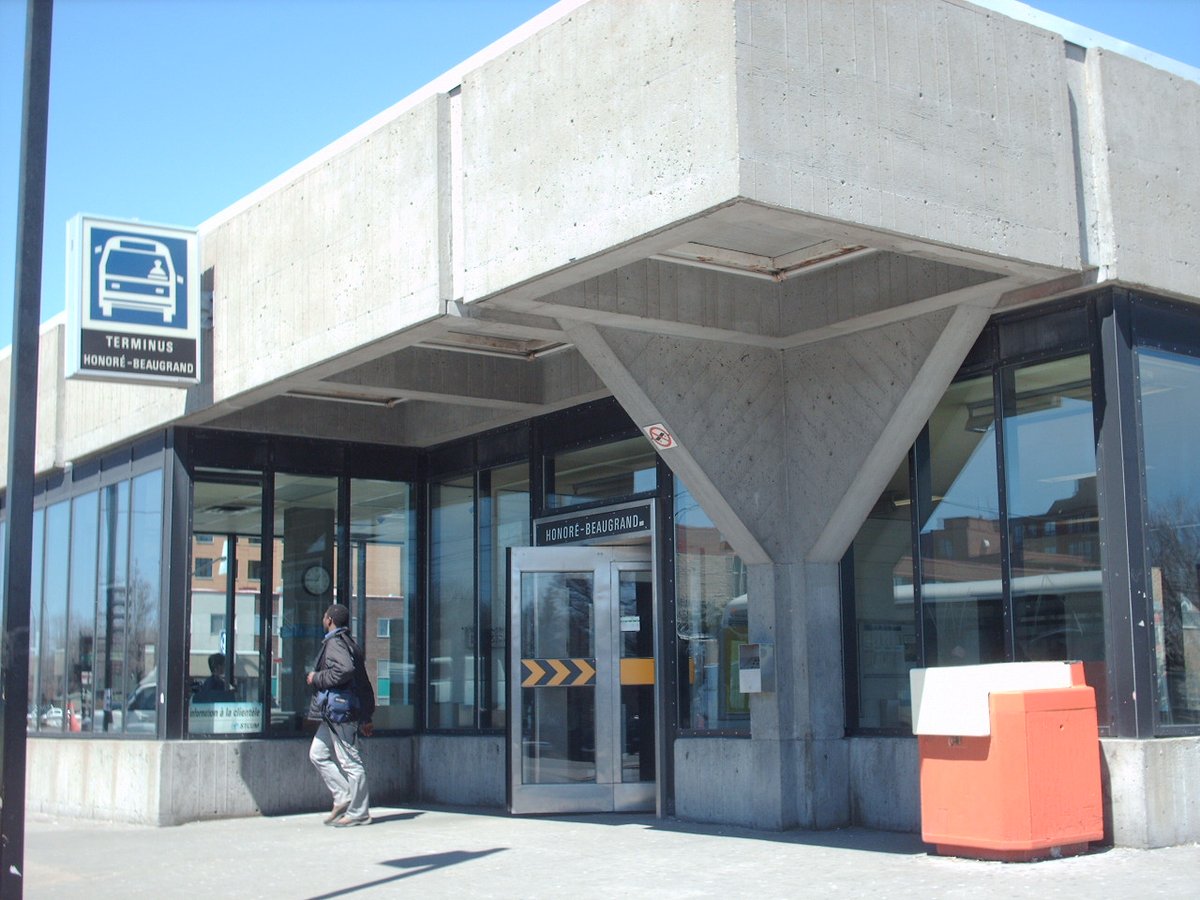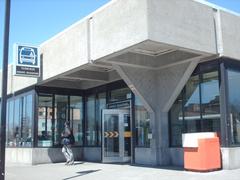
Honoré-Beaugrand Montreal Visit Guide: Tickets, Hours, History, and Tips
Date: 15/06/2025
Introduction: Discovering Honoré-Beaugrand Station’s Legacy
Honoré-Beaugrand station stands as the vital eastern terminus of Montreal’s Green Line Métro system. More than a transit hub, it serves as a gateway into Montreal’s history, culture, and urban development. Opened in June 1976 during the transformative era of the 1976 Summer Olympics, Honoré-Beaugrand station reflects Montreal’s commitment to innovative public transportation, architectural distinction, and cultural heritage (STM Metro History). Named after the influential Montreal mayor and folklorist Honoré Beaugrand, the station is itself a celebration of local history and art, featuring iconic ceramic murals by Quebec artist Jean-Paul Mousseau and the architectural vision of Yves Bernard.
The station’s creation was part of a citywide response to rapid urbanization in the mid-20th century, aimed at improving mobility and showcasing architectural and artistic excellence. Today, Honoré-Beaugrand serves thousands of daily commuters, offering extensive accessibility features, modern ticketing options, and proximity to top attractions in the Mercier–Hochelaga-Maisonneuve borough. This guide provides essential information for your visit, covering operational hours, ticketing, accessibility, the station’s cultural significance, nearby sites, and practical travel tips to enrich your experience at one of Montreal’s key metro destinations.
Contents
- Introduction
- Montreal’s Urban Growth and Rapid Transit Needs
- The Birth of the Montreal Métro and Green Line
- Honoré-Beaugrand Station: Inauguration and Expansion
- The Meaning Behind the Name: Honoré Beaugrand
- Art and Architecture at Honoré-Beaugrand
- Visiting Information: Hours, Tickets, and Accessibility
- Local Attractions and Neighborhood Highlights
- Modernization and Recent Upgrades
- Frequently Asked Questions (FAQs)
- Summary and Recommendations
- Sources and Official Links
Montreal’s Urban Growth and Rapid Transit Needs
By the mid-20th century, Montreal’s growth brought increased congestion and mobility challenges. Though subway proposals date back to the 1910s, it was not until the 1950s that serious planning began. In 1953, the Montreal Transportation Commission proposed a 12.5 km métro line, but political and financial caution delayed the project (STM Metro History). Meanwhile, Toronto opened its subway in 1954, demonstrating the transformative power of rapid transit.
The Birth of the Montreal Métro and Green Line
The election of Mayor Jean Drapeau in 1960 marked a turning point. An ambitious blueprint for three metro lines was presented in 1961, with construction starting in 1962. Montreal’s métro was the first in North America to use rubber tires for a quieter, smoother ride, and all stations were built underground to withstand harsh winters. Each station received a unique architectural design, and over 5,000 workers contributed to the project (STM Metro History). The system was ready for Expo 67, with 26 stations and three lines completed by spring 1967.
Honoré-Beaugrand Station: Inauguration and Expansion
The green line’s initial segment ran from Atwater to Frontenac, but the 1970s brought a major extension eastward. Construction toward Honoré-Beaugrand began in 1971 despite economic challenges, with the station finally opening on June 6, 1976 as the new eastern terminus (TransitFan Honoré-Beaugrand). The extension was pivotal for connecting the Mercier–Hochelaga-Maisonneuve borough to the rest of the city.
The Meaning Behind the Name: Honoré Beaugrand
Honoré-Beaugrand station and the surrounding street honor Honoré Beaugrand (1848–1906), a prominent Montreal journalist, folklorist, and mayor. Beaugrand’s career included military service in Mexico, journalism in the United States, and the founding of the newspaper La Patrie in Montreal. He became mayor in 1885, notably advocating for public health during a smallpox epidemic (Ville de Montréal Archives). Beaugrand is also celebrated for publishing the legendary Quebec tale “Chasse-galerie” and other folklore, cementing his place in local culture (Wikipedia: Honoré Beaugrand).
Art and Architecture at Honoré-Beaugrand
Designed by architect Yves Bernard, Honoré-Beaugrand station is a showcase of modernist urban design and public art. The highlight is Jean-Paul Mousseau’s vibrant ceramic murals, which infuse the space with color and cultural meaning (TransitFan Honoré-Beaugrand). The station’s design exemplifies Montreal’s tradition of integrating art into public spaces.
Visiting Information: Hours, Tickets, and Accessibility
Hours:
- Open daily from approximately 5:30 AM to 1:00 AM.
- Service frequency varies; check the STM official website or app for up-to-date schedules.
Tickets and Fares:
- Purchase single-ride tickets, day passes, or reloadable OPUS cards at vending machines or via the STM app (STM Tickets).
- OPUS cards offer convenience for regular travel.
Accessibility:
- The station is fully accessible with elevators, ramps, tactile paving, and audible announcements for travelers with reduced mobility.
- Recent renovations (completed in 2018) have further improved step-free access.
Facilities:
- 84 exterior bike parking spaces encourage sustainable transit (STM Cyclists).
- Restrooms, seating areas, and real-time transit screens are available.
Local Attractions and Neighborhood Highlights
Mercier–Hochelaga-Maisonneuve Borough:
Explore the area’s working-class roots and vibrant urban renewal.
Sherbrooke Street East:
A lively corridor with shops, cafés, and local businesses.
Parc de la Promenade-Bellerive:
A nearby riverside park ideal for walks and photography.
Parc Angrignon and Centre Pierre-Charbonneau:
Large urban parks and recreational facilities easily accessible from the station.
Quartier SOHO Development:
Modern residential and commercial spaces reflecting Montreal’s evolving cityscape.
Art and Cultural Tours:
While there are no official tours of the station, local organizations may offer borough walking tours that include Honoré-Beaugrand as a key stop.
Modernization and Recent Upgrades
The STM has continually invested in upgrades, including park-and-ride lots, electronic displays, and the introduction of new train cars like the MPM-10. The Réno-Systèmes program (launched in 2004) ensures ongoing renovations to keep stations safe, accessible, and efficient (STM Metro History).
Frequently Asked Questions (FAQs)
Q: What are the operating hours of Honoré-Beaugrand station?
A: Approximately 5:30 AM to 1:00 AM daily.
Q: How do I buy tickets?
A: Purchase at vending machines, online, or via the STM app. OPUS cards are recommended for convenience.
Q: Is the station accessible?
A: Yes, with elevators, ramps, tactile paving, and step-free access.
Q: Are there bike parking facilities?
A: Yes, there are 84 exterior bike parking spaces.
Q: Are there restrooms?
A: Yes, restrooms are available on-site.
Q: What attractions are nearby?
A: Parc de la Promenade-Bellerive, Sherbrooke Street East, Mercier–Hochelaga-Maisonneuve borough, and more.
Q: Does the station have guided tours?
A: No official tours, but local walking tours may feature the station.
Summary and Recommendations
Honoré-Beaugrand station exemplifies Montreal’s spirit of innovation, community identity, and artistic expression. From its roots in the city’s mid-century expansion to its present role as a fully accessible gateway to the east end, the station offers both practical amenities and cultural enrichment. Take the time to appreciate Jean-Paul Mousseau’s murals, explore the surrounding neighborhoods, and enjoy seamless connections to the rest of Montreal. For a smooth visit, use the STM or Audiala mobile apps for real-time updates, fare information, and travel planning.
Sources and Official Links
- STM Metro History
- TransitFan Honoré-Beaugrand
- Ville de Montréal Archives
- Wikipedia: Honoré Beaugrand





























































































































